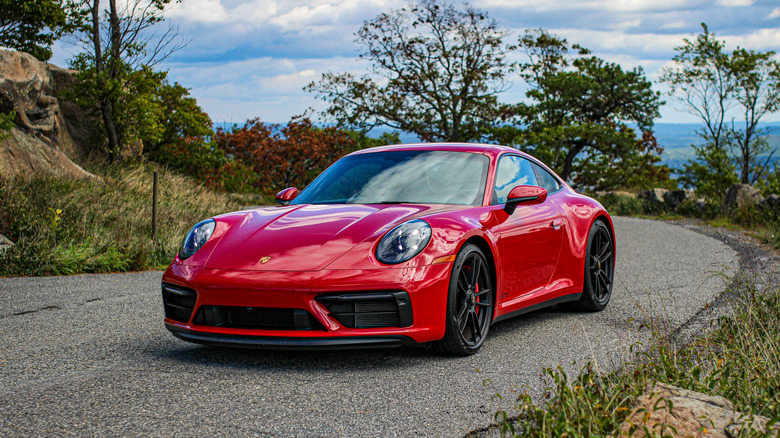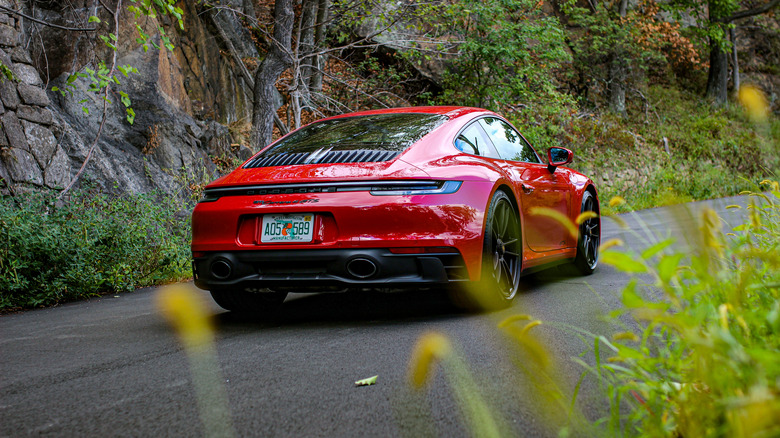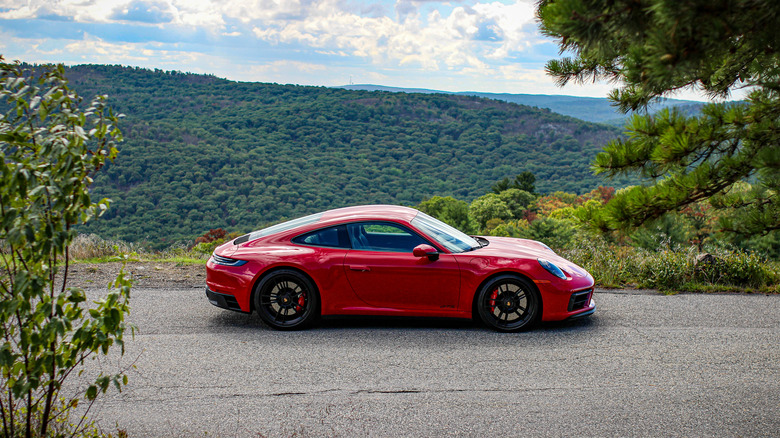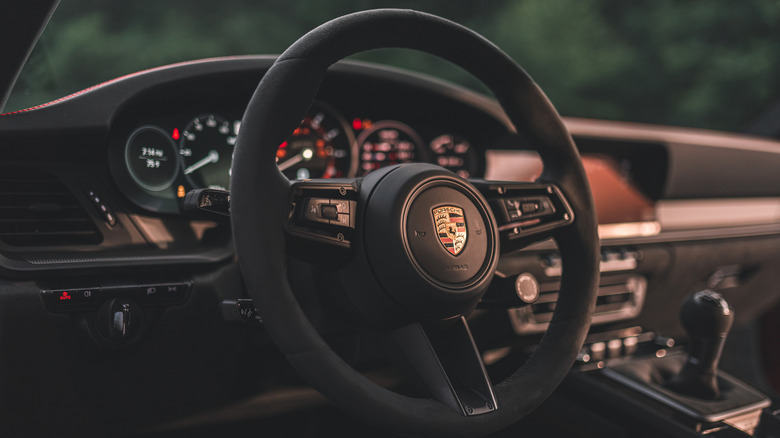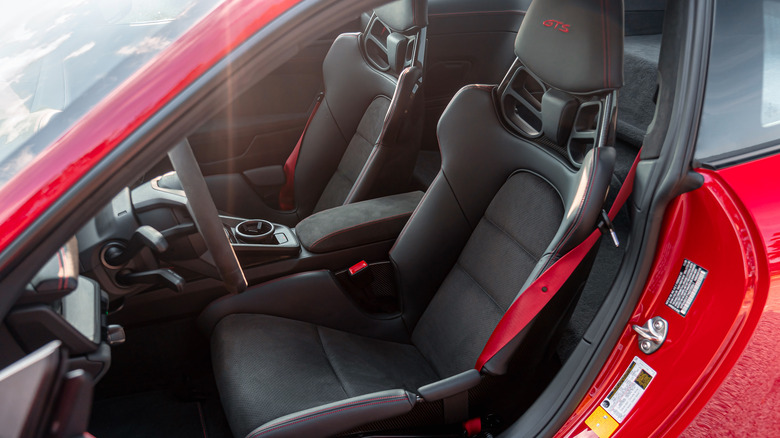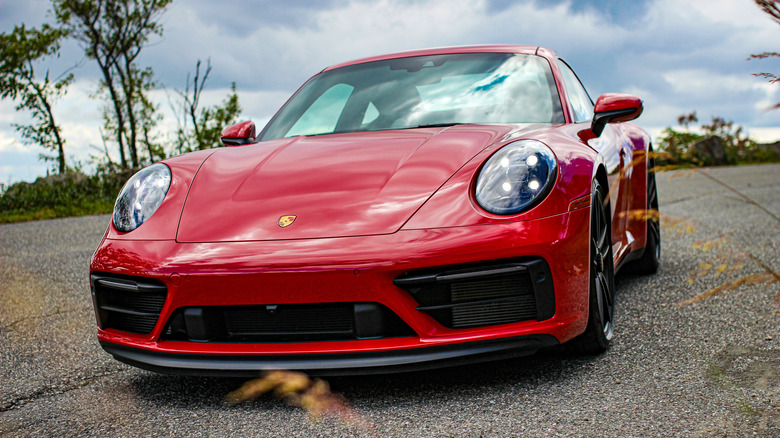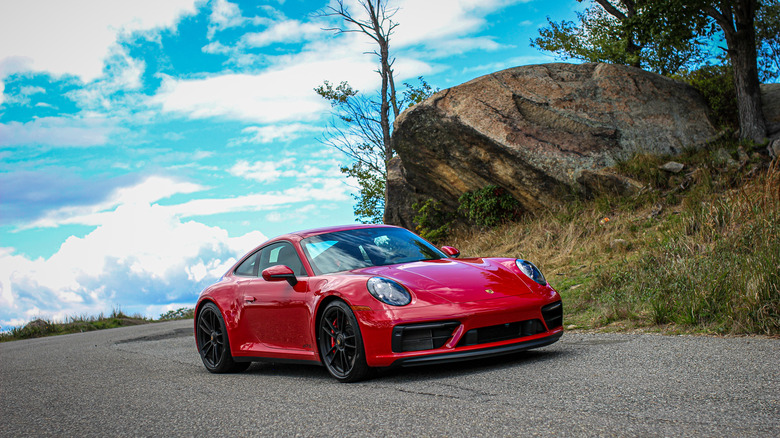2022 Porsche 911 Carrera 4 GTS Review: Top-Shelf Performance
- Refined performance
- Focused cabin
- The high cost of quality
How well do you know yourself? How honest would you be if confronted with a younger version of you? The one who once said "if I ever have such-and-such job, punch me in the face," or scoffed at certain types of music and fashion. Heaven forbid you ask them about their taste in movies. Would they hate you? Would you feel ashamed of what you have become?
Sometimes there's a fear of allowing ourselves to enjoy certain things, particularly when doing so feels like a watershed moment in life. If it makes you feel better, the likelihood is the period of maturity that (hopefully) happened between now and then would indeed make you different from that past version, but you would be okay with it. Finding a taste for scotch, jazz and Porsches (not in that order, for the record), isn't a betrayal of the kid-you, hopped up on sugar, ska and Supras, it's growth.
Climbing into the Porsche 911 Carrera 4 GTS feels like such a moment, when the silliness of sports cars gives way for a jarring level of seriousness. The good news is, just because something is mature doesn't make it boring.
Get you a Porsche that does both
The Porsche 911 GTS is nestled comfortably at the top end of Porsche's 911 range, right before it spins off into the track-focused GT3 versions. GT3 itself is a mini series of its own, made up of the RWD coupe and cabriolet, AWD versions of the same, and an AWD Targa iteration. Prices start at $136,700 and raise up to $156,800 without additional packages or fees.
Mounted at the rear is a twin-turbo 3.0-liter 6-cylinder boxer engine that blazes up 473 horsepower and 420 pound-feet of torque. This unit squeezes more power out thanks to an increase in boost pressure, giving it superior grunt over the 911s that sit beneath it in the lineup. Depending on the model, power is sent to either the rear or all four wheels by way of a 7-speed manual or an 8-speed PDK or dual clutch automatic. This is the standard and demonstrably more effective gearbox, but those who wish to row their own can opt for the manual at no extra cost, apart from speed. Using launch control with the PDK can send the 911 4 GTS from 0 to 60 in 3.1 seconds, while the best the manual can manage is 3.9 seconds. How much of a difference that makes as far as individual enjoyment is questionable, but Porsche fans are nothing if not detail oriented.
All but the Targa versions get upgrades like an active sport suspension with aptly named helper springs on the rear axle to increase stability, a carryover from the 911 Turbo models, which also includes the hefty 408 mm front and 380 mm rear brakes. There's also a handful of performance options like rear axle steering, dynamic chassis control, and ceramic brakes.
If it ain't broke...
You know the look, it's a Porsche 911, though in its most modern and sleek guise. As we've seen on other models, like the Taycan GTS and Cayenne GTS, the GTS-specific cues are subtle but distinct. Thanks to the standard sport suspension, the 911 GTS coupe and cab sit 10 mm lower, for starters. Most features are darkened for a more serious tone, like elements of the front fascia, intakes, and smoked-out headlamps. It's the same deal around back, where you'll find black tailpipes, a dark-tinted light strip, and black slats over the rear grille.
All of it is rounded out by black center locking 20- or 21-inch wheels borrowed from the 911 Turbo S. In theory, this should be fairly low-key but it can't help but turn heads, especially when spotted by true-blue Porsche enthusiasts. As it happens, it's only more stealth than the winged-out GT3.
No compromise
With car interiors increasingly becoming showcases for gadgetry, they've broadened to feature as much as possible. In the case of the 911, though, and indeed other cars in Porsche's portfolio, it's made the technology fit its design, not the other way around. The GTS has a very tight interior with a streamlined mix of physical buttons and touchscreen menus accessed by the 10.9-inch center display. This is a refreshingly balanced approach as it allows the modern technological conveniences to enhance the cockpit without making it the centerpiece. Two small configurable digital screens flank the analogue tachometer behind the wheel to further support the driver.
The rest of the interior is a very neat package swathed in leather and grippy race-tex microfiber material. Optional carbon fiber bucket seats forcefully hold passengers in place and contribute to the GTS's weight reduction methods, such as utilizing lightweight glass for everything apart from the front windshield, removing the nobody-fits-there-anyway rear seats, and even ditching the floor mats. The GTS also has reduced its layers of sound deadening which goes a long way to increase the driver's engagement.
Business casual
The ride, reduced sound baffling, and weight reduction options give the Porsche 911 GTS this wonderfully old-school sensation. With the boxer engine's distinct chattering dominating the surrounding air, its civility feels thinly draped over the performance-oriented framework underneath, like a light aircraft or the race cars of old.
From hands to haunch, the ride is best described as stiff. The heavy steering and braking demand more than passive engagement for even the most casual journeys. This is exacerbated by the sport suspension that is hesitant to yield to even the smallest bumps in the road. This is the price paid for a car like the GTS that purports to split the difference between being a daily driver and a track-attacking precision instrument; at the end of the day, it will always favor dynamic performance over comfort. Like a new pair of gloves, it takes a bit of breaking in, but it's worth it in the end.
The metaphorical gloves are decidedly off when the 911 GTS is kicked out if its default driving mode and pushed up into sport or sport+. As soon as the boxer engine fires up, the 911 GTS is constantly egging you on to get a move on. The smoothness of how power is dialed in through the throttle is only matched by how easily the PDK transmission fires through the gears, punctuating every shift with declarative finality.
Smooth criminal
Given enough room to stretch its legs, the Porsche can get up to troublemaking speeds alarmingly quickly. There's also the matter of the sport response button that PDK-equipped Porsches have integrated onto the steering wheel, acting as a teeny enabler. Press it and the GTS's powertrain is simply unhinged, instantly changing the transmission response and engine mapping to make the car's maximum output available for 20 solid seconds. It feels thrilling when used for quick overtakes, and the countdown is helpful to keep you from pushing the 911 GTS beyond both its limits and your own.
Though never threatening to get out of sorts, the all-wheel-drive system of the Carrera 4 GTS was welcome as corners are predictably dispatched, with the sport suspension and rear-wheel steering performing in a manner that reduces any potential drama to the bare minimum. This is the main distinguishing factor between the AWD and RWD versions of the GTS, and whether or not it's for you boils down to expectations and preference.
Whatever the choice, the 911 GTS's tautness proves its value by communicating a high degree of information through the wheel and the seat. The GTS feels hyper connected to the rubber and, in turn, so do you.
Definite article
Like an expensive watch, the 911 Carrera 4 GTS is luxurious in a way that's more about its authenticity than the collection of premium materials that hold it together. The same qualities that make something like a TAG Heuer timepiece attractive enough to justify its often eye-watering price tag are the ones that give the 911 license to be a standard-setter in the luxury sports car segment. And make no bones about it, there is indeed a high cost of entry into this exclusive club. As mentioned before, the RWD 911 GTS starts at $136,700 and that climbs quickly when other models and options are factored in. A fully kitted-out Carrera 4, for example, can easily sport a $170,000 bottom line.
What separates the G-Shocks and the Supras — that I'm unfairly singling out because it rhymed earlier — isn't a lack of capability or quality, but a level of refinement that isn't easily replicated without spending an equal amount of time iterating on the same formula over and over again, making it smoother and more potent with each new incarnation. Like a premium timepiece, the Porsche 911 GTS is rewarding in its engineering intricacy, and the results are tangible in its performance. There might be a smidge of "paying for the label" here, but there's no denying the quality of the real deal.
